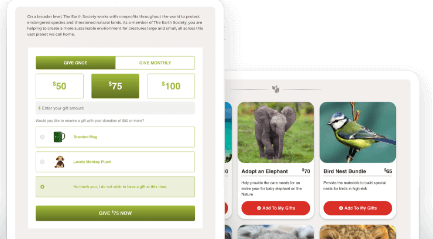The end of year giving season is a crucially important time for nonprofits and organizations of all sizes. With 30% of all giving happening in December, the year-end fundraising rush means that donors receive an influx of messages and solicitations from nonprofits. In that cluttered landscape, it can be easy for donors to miss—or even tune out—your message.
To fully leverage donor generosity at year-end, your organization might be looking for ways to break through the clutter. The good news is that with some simple changes in messaging and promotion, your organization’s end-of-year fundraising campaign can stand out. So, what are the best ways to empower year-end donors to take action? How can these simple changes to your existing strategy fuel your fundraising efforts?
We recommend the following best practices:
- Communicate progress towards your goals.
- Market matching gifts to your donors.
- Personalize your appeals.
Let’s dive into each with more detail now!
1. Communicate Progress Towards Goals.
Many organizations set yearly fundraising goals, and throughout the year, you likely track progress towards those goals. At year-end, communicating that progress externally and involving donors in your goals can be key. When donors see your organization pushing forward towards that goal, they will likely feel compelled to take action. Remember, donors want to see you succeed!
Let’s take a look at how you might communicate that progress with a sample appeal: “John, this year, we set out to feed 100,000 families. With the help of our generous donors, we are 75% of the way towards achieving that goal. Join us in finishing the year strong to give those families the nourishment they need!”
To maximize the reach this messaging has, you should consider adopting a multi-channel communication approach. Provide progress updates within your newsletters, on your social media accounts, in your email campaigns, and through any other communication avenues your organization uses on a regular basis. Optimizing your usage of these platforms ensures that all of your supporters hear about the progress, and therefore buy into the goal so you succeed.
2. Market Matching Gifts.
Although matching gifts can provide your organization an invaluable fundraising lift, $4-$7 billion in matching gifts are left on the table every year. The reason for this matching gift revenue gap is primarily due to donors being unaware that they are eligible for such programs. At year-end, you want to close that donor awareness gap and drive matches to completion! Marketing matching gifts and helping donors determine their eligibility can allow you to do just that. Using a matching gift database can make it even easier for donors to receive detailed next steps regarding the matching gift process.
Plus, matching gifts appeals can even empower more donors to take action. Studies suggest that 84% of individuals are more likely to donate if their gift is matched, and 1 in 3 donors will give a larger gift if it will be matched. At a time when supporters are looking to maximize their generosity, matching gifts allow them to do so without digging deeper into their pockets.
The matching gift appeal is simple to craft and communicate. For example, tell your donor: “Maria, did you know that you could double your impact on our mission this year? Determine if your employer offers a matching gift program by searching this matching gift database.”
Along with promoting matching gifts proactively to prospective year-end donors, you can also reach out retroactively to match-eligible donors who contributed throughout the year. Since many companies require matching gift requests to be submitted before year-end, it is important that match-eligible donors submit that request before their eligibility window closes. By creating that sense of urgency, you will be sure to drive more matches to completion that may otherwise have gone unclaimed. As a result, your fundraising revenue can quickly skyrocket!
3. Personalize Your Appeals.
Perhaps more than any other time of year, personalizing your fundraising appeals at year end is crucial. Since donors are receiving so many generic calls to action, you can stand out by customizing your appeals.
Even something as simple as addressing donors by their first name in an email can help your appeal seem tailored. The less generic a fundraising appeal is, the more a donor feels like their contribution matters and will make a real difference.
As another example, if you know a donor’s preferred communication channel, make the call to action through that platform. If you are communicating with a multi-year donor, address what their generosity over the years has done and ask them to continue their contributions. With recurring donors, ask them to upgrade their gift this month.
In other words, strategic segmentation increases the relevance of your appeals to each recipient, and may include characteristics such as:
- Donor type (major, lapsed, first-time, multi-year, etc.)
- Giving preferences (check, giving wallets, monthly donors, etc.)
- Communication preferences (social media, email, direct mail, etc.)
Use the data you have on hand to make your appeal as specific and relevant as possible. Donors will appreciate the effort and will feel more connected to your organization.
Putting It Into Practice
By incorporating these practices into your existing strategy, you will position yourself for a strong end of year season. All of these strategies help your organization show that you value donors and want to deepen the relationship, which are key to both conversion and retention among supporters.
Plus, we know that a successful year-end fundraising season can also pave the way for a strong start next year. Remember to maintain the giving momentum and continue nurturing your supporters in Q1 and beyond.
We wish you the best in this coming season!





